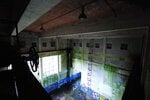Visited with @Chloe Explores
We tried here earlier in the year but failed, as we were in the area we tried it again and managed to get in.
Unfortunately all but one of the buildings were inaccessible having had entrances blocked by huge mounds of dirt or huge boards. Had a nice time wandering round the huge site though. There is still some track remaining from the train that ran there, lots of bizarre fungi in the woods like a puffball that shot out some green gas when squished and our only companion was a lone pheasant making enough noise for 8 of them.
Its a shame the buildings are all shut as would loved to have seen inside them, the one that was open was huge but wasn’t brave enough to try the ladder.
History -
Snowdown was the deepest mine in Kent at 3083 feet. Work commenced in 1908, and coal was first brought to the surface on 19 November 1912. The first shaft sunk hit water at 260 feet (79 m) and 22 men were drowned. Snowdown, reaching a depth of 3,083 feet (940 m). The colliery was served by the Faversham to Dover railway, and a halt (Snowdown and Nonington Halt) was provided. In 1945 the workforce was 1,876, with 1,523 being employed sub-surface and 353 above. The colliery closed in 1987 and the shafts were capped in 1988. A few ruinous buildings remain today.
Shafts sunk
No 1. 262 feet (80 m)
No 2. 3,083 feet (940 m)
No 3. 2,994 feet (913 m)
Snowdown Colliery railway
The colliery had an extensive internal standard gauge rail network, connected to the mainline at Snowdown and Nonington Halt. The line was operated by steam locomotives, the last of which survived in working condition after the demise of steam traction on the national mainline in 1968. The colliery railway was by then using a mixed fleet of steam and diesel locomotives, with the final steam withdrawals taking place in the late 1970s. The final three steam locomotives were named after saints with nearby Canterbury connections. St Thomas (named for St Thomas of Canterbury), St Dunstan (named for Dunstan, also a medieval Archbishop of Canterbury), and St Martin (named for St Martin, patron of England's oldest parish church, St Martin's Church, Canterbury). The colliery railway network was dismantled following the closure of the colliery in 1987. St Thomas and St Dunstan both survive into preservation. St Martin, which had been badly damaged when its tanks were left full of water which froze on a winter night, was scrapped.



















We tried here earlier in the year but failed, as we were in the area we tried it again and managed to get in.
Unfortunately all but one of the buildings were inaccessible having had entrances blocked by huge mounds of dirt or huge boards. Had a nice time wandering round the huge site though. There is still some track remaining from the train that ran there, lots of bizarre fungi in the woods like a puffball that shot out some green gas when squished and our only companion was a lone pheasant making enough noise for 8 of them.
Its a shame the buildings are all shut as would loved to have seen inside them, the one that was open was huge but wasn’t brave enough to try the ladder.
History -
Snowdown was the deepest mine in Kent at 3083 feet. Work commenced in 1908, and coal was first brought to the surface on 19 November 1912. The first shaft sunk hit water at 260 feet (79 m) and 22 men were drowned. Snowdown, reaching a depth of 3,083 feet (940 m). The colliery was served by the Faversham to Dover railway, and a halt (Snowdown and Nonington Halt) was provided. In 1945 the workforce was 1,876, with 1,523 being employed sub-surface and 353 above. The colliery closed in 1987 and the shafts were capped in 1988. A few ruinous buildings remain today.
Shafts sunk
No 1. 262 feet (80 m)
No 2. 3,083 feet (940 m)
No 3. 2,994 feet (913 m)
Snowdown Colliery railway
The colliery had an extensive internal standard gauge rail network, connected to the mainline at Snowdown and Nonington Halt. The line was operated by steam locomotives, the last of which survived in working condition after the demise of steam traction on the national mainline in 1968. The colliery railway was by then using a mixed fleet of steam and diesel locomotives, with the final steam withdrawals taking place in the late 1970s. The final three steam locomotives were named after saints with nearby Canterbury connections. St Thomas (named for St Thomas of Canterbury), St Dunstan (named for Dunstan, also a medieval Archbishop of Canterbury), and St Martin (named for St Martin, patron of England's oldest parish church, St Martin's Church, Canterbury). The colliery railway network was dismantled following the closure of the colliery in 1987. St Thomas and St Dunstan both survive into preservation. St Martin, which had been badly damaged when its tanks were left full of water which froze on a winter night, was scrapped.

